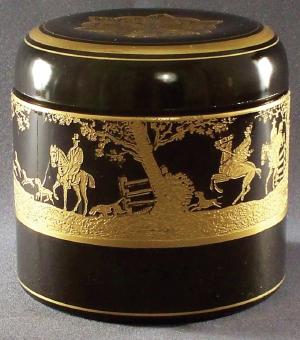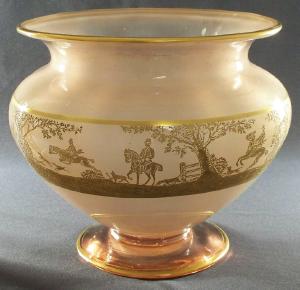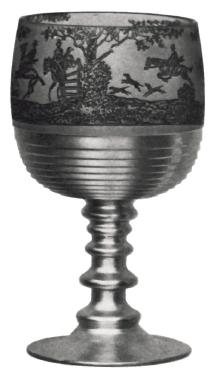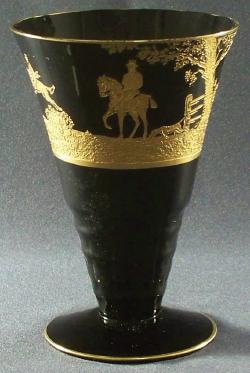Etching No. 718
by Mark Nye
Issue No. 465 - February 2013
The following article was adapted from a program presented at the 2012 NCC Inc. Annual Convention.
Like the elusive fox, not to be seen in the etching, the etching itself is about as elusive when trying to establish its Cambridge Glass Company history. Considering Arthur Bennett's British origins, the concept of an etching depicting fox hunting might have come directly from him but that is only conjecture as there are no records to indicate this.
Little is known about the etching's history
and its years in the Cambridge line. We do
know from a signature on an etching plate,
that at least some of the etching plates, if
not all, were prepared for Cambridge by the
J. C. Bragdon Company. Surviving are 23
individual segments. Whether or not there
were additional plates, or if each segment was
 used for multiple items, is a question that will
probably never be answered. We do know,
on occasion, etching plates no longer in use were
recycled and made into tools.
used for multiple items, is a question that will
probably never be answered. We do know,
on occasion, etching plates no longer in use were
recycled and made into tools.
Etch 718 first appears on a catalog page that in all probability dates to 1927. The page is captioned 3085 Line D.P.E 718. Shown on a subsequently issued catalog page, probably dating to 1928, are the No. 711 and 712 jugs (identical except 712 has no lid.) captioned E718. In this same catalog the etching also appears on an Ebony No. 1025 cigar humidor, gold encrusted, again simply identified as E718 (and shown at right).
At some point in its early years, perhaps 1928, an unknown quantity of pieces in Pomona Green (us old timers know this as Avocado) were etched No. 718. Production, samples or trials it is hard to say but, due to the scarcity of these items, what is clear is that not much was made.
Circular Letter No. 41 from 1929 (The specific date is not
known.) was essentially an availability/price list and, along
with other etchings, offered E718 on 3075, 3077, 3087 and
 3085 stemware as well as associated pieces. How long these
remained available is not known. This same circular letter
made known the availability of 3085 stemware and associated
pieces with D/805, gold encrusted Imperial Hunt.
During this time period 1927-1930, there is no currently
known mention of the etching, either by number or name,
in the trade journals.
3085 stemware as well as associated pieces. How long these
remained available is not known. This same circular letter
made known the availability of 3085 stemware and associated
pieces with D/805, gold encrusted Imperial Hunt.
During this time period 1927-1930, there is no currently
known mention of the etching, either by number or name,
in the trade journals.
At the beginning of 1930, Cambridge issued a new catalog and price list. Again, the subject etching is identified only by its number, Etch 718, in both the catalog and the accompanying price list. Offered were bridge sets, ice pails and a water or ice tea set. A bridge set consisted of four tumblers on a handled tray, often marked with the four card suits. The price list made no mention of most of the items from the 1929 price list nor was there any reference to the pieces being available gold encrusted. Catalog supplements issued through the end of 1931 included no further offerings of E718.
It wasn't until the 1932 catalog supplement
was issued that we once again see Etch 718.
On the initial page of the new Tally Ho line
is shown the 18 oz pressed goblet etched
E.718 (shown at right) but now captioned Imperial Hunt.
 The implication is that the complete line of
pressed Tally Ho stemware was available etched
Imperial Hunt but we have no price list to confirm
this. The pieces that have been reported tend to
indicate most, if not all, of the pressed stemware
line was available etched Imperial Hunt.
The implication is that the complete line of
pressed Tally Ho stemware was available etched
Imperial Hunt but we have no price list to confirm
this. The pieces that have been reported tend to
indicate most, if not all, of the pressed stemware
line was available etched Imperial Hunt.
Over the years it is known to have been in production, there are minimal trade journal references to the etching, either in Cambridge ads or trade reports. "The Imperial Hunt etching by the Cambridge Glass Company on their new Tally Ho patented line is pictured above. It is made in a complete pressed stemware line ranging from the 18 oz goblet to a 1 oz. cordial and also in fancy tableware and novelty pieces in a range of the Cambridge colors as well as crystal." The illustration consisted of a two handled plate and a pressed stemware item. This is from the October 1932 issue of China, Glass and Lamps.
All sorts of interpretations can be made of the preceding. Does 'it' refer to the Hunt Scene etching or to the Tally Ho line? Does the Hunt Scene etching appear on colored Tally Ho blanks or just Crystal? How much of the Tally Ho line was offered with the Hunt Scene etching? Hunt Scene is known on Tally Ho blanks other than stemware but not to the extent other etchings are. Questions but no definitive answers.
In January 1933 issue of China Glass and Lamps was this
comment. "The Cambridge Glass Company is ready to
show the trade some mighty smart ideas
as the New Year comes in. Here are
some of them. The crystal decanter on
the left shows the etched Catawba grape
design, while the tumbler with it features
the etched Imperial Hunt pattern. The
decanter on the right is the same shape
only with a handle, and both may be
hand in crystal, amber, forest green,
 royal blue and Carmen, either plain or
etched." The decanters shown were the
Tally Ho decanters while the tumbler
referred to is the Tally Ho 1402/37 2½
ounce handled tumbler that resembles a
small mug. Again, this report is subject
to interpretation. Unfortunately this is
true of many written items found in the
trade journals.
royal blue and Carmen, either plain or
etched." The decanters shown were the
Tally Ho decanters while the tumbler
referred to is the Tally Ho 1402/37 2½
ounce handled tumbler that resembles a
small mug. Again, this report is subject
to interpretation. Unfortunately this is
true of many written items found in the
trade journals.

No further mention of Etch 718 appears in the trade journals. How long it remained available is not known but no doubt it was out of the Cambridge line by the late 1930s. Hunt Scene's "heyday" appears to have been in the period 1927-1929.
Hunt Scene is predominately found on Amber, Light Emerald and Peach-blo blanks. Next comes Willow Blue and Crystal. Hunt Scene was also placed on Ebony blanks as well as Pomona Green. One color that is missing from the "stable" so to speak is Gold Krystol, introduced in late summer 1929. This may be an indication the use of Hunt Scene had declined by that time or it just may be a case of the sales agents not liking the combination.
There is another question. What is the etching's proper name? I know we all refer to it as Imperial Hunt Scene but I have not found any reference to this name in company documents. The few that do mention the etching by name refer to it as Imperial Hunt. Did we as Cambridge collectors add the word "scene" in the early days? I think probably so but will give way to anyone who can prove otherwise.
A listing of the currently known Hunt Scene etched Cambridge blanks was made available to those attending the Hunt Scene program presented at the 2012 NCC, Inc. Convention. This listing included a description of the item, the colors in which it is known etched Hunt Scene and whether or not the known piece is gold encrusted. Also included in the listing are items from Cambridge price lists but not necessary in a collection at this time. As stated during the program, this listing is not being presented as "the definitive" list. It is a work in progress and individuals are urged to contact the author with additions or corrections.
Anyone wishing a printed copy of this
listing should send a request along
with a self addressed stamped envelop
(SASE) to:
NCC, Inc.
Hunt Scene Request
PO Box 416
Cambridge, OH 43725-0416
Requests without a SASE will not
be filled nor acknowledged. Please
allow two – three weeks for delivery.
The listing may also be had via email
in PDF format. Send request for an
email copy to Nyetowers@att.net.
